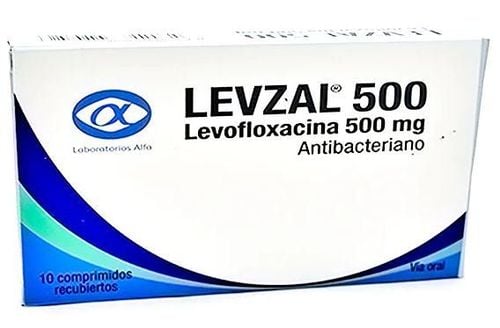This is an automatically translated article.
Quinotab is also used to treat infections after respiratory exposure, bacterial infections. Levofloxacin belongs to a group of medicines called quinolone antibiotics.
1. What is Quinotab?
Quinotab contains the ingredient Levofloxacin which is used to treat bacterial infections. It is useful for treating infections such as sinusitis, chest infections, urine infections, prostatitis and some skin and soft tissue infections. It works by killing the bacteria that is the cause of the infection.
Other antibiotics are often prescribed instead of levofloxacin. Levofloxacin is reserved for infections that do not improve with treatment with other antibiotics. It is also used if other, more preferred, antibiotics cannot be prescribed for some reason.
2. Uses of Quinotab
Quinotab is used to treat infections of the sinuses, skin, lungs, ears, airways, bones, and joints caused by susceptible bacteria. Quinotab is commonly used to treat urinary tract infections, including those that are resistant to other antibiotics, as well as prostatitis (infection of the prostate gland). The drug is effective in treating infectious diarrhea caused by E. coli, and Shigella bacteria. The drug can be used to treat various obstetric infections, including mastitis (infection of the breast). Inhalation anthrax exposure is also treated with levofloxacin. It is used to prevent and treat bubonic plague caused by the bacteria Yersinia pestis.3. Things to know before taking Quinotab
Some medicines are not suitable for people with certain conditions and sometimes medicines can only be used with extra care. For these reasons, before you start taking it, it is important that your doctor know:
If you are pregnant, trying to have a baby or are breast-feeding. If you are under 18 years old. If you've ever had a problem with your tendon, called tendinitis. If you have any problems with the way your kidneys work. If you have epilepsy or any other condition that causes fit. If you have ever had a mental health problem. If you have heart disease, or if you have been told that you have an irregular heartbeat. If you have an aortic aneurysm or a family history of aneurysms. If you have a condition that makes your muscles tired and weak, it's called myasthenia gravis. If you know you have glucose 6-phosphate dehydrogenase (G6PD) deficiency. This is a genetic disorder that causes problems after eating foods like beans. If you are taking any other medicines. This includes any medications you are taking that are available to buy without a prescription, as well as herbal medicines and supplements. If you have ever had an allergic reaction to a medication. It is especially important that you tell your doctor if you have problems after taking another quinolone antibiotic (these are called norfloxacin, ofloxacin, ciprofloxacin, moxifloxacin, and nalidixic acid).
4. How to take Quinotab
Before you start taking the medicine, read the manufacturer's printed information leaflet from the inside of the pack. The manufacturer's leaflet will give you more information about the medicine and a full list of the side effects you may experience while taking it.
Take Quinotab exactly as your doctor tells you to. The usual dose is 500 mg per day, although for some types of infections a dose of 250mg per day is sufficient and for others 500 mg twice daily is required.
You can take the medicine before or after a meal. If you are taking one dose a day, it is better to take it in the morning. If you are taking more than one dose per day, try to reduce your dosage so ideally take one pill every 12 hours.
Many people find it helpful to swallow pills with water. You can break the tablet in half along the number line if needed, but do not crush or chew the tablet.
Do not take indigestion medicines (antacids) or medicines containing iron or zinc (such as multivitamins) for two hours before you take them, or for two hours after you take a dose. This is because these drugs interfere with how your body absorbs it and prevent it from working completely.
If you forget to take a dose, take it as soon as you remember. If when you remember, your next dose is due take the dose that is due but skip the missed dose. Do not take two tablets together to make up for a missed dose.
Even if you feel the infection has cleared up, continue to take the antibiotic until the end of the course (unless your doctor tells you to stop). This is to prevent the infection from coming back. A course of treatment usually lasts 7-14 days. If you still feel unwell after finishing your course of pills, go back to see your doctor.
5. Side effects of drugs
Common side effects of Quinotab include:| Những tác dụng phụ thường gặp của levofloxacin (những tác dụng này ảnh hưởng đến ít hơn 1/10 người) | Tôi có thể làm gì nếu gặp phải trường hợp này? |
|---|---|
| Cảm thấy buồn nôn (buồn nôn) hoặc ốm (nôn) | Hãy ăn uống đơn giản - tránh các bữa ăn nhiều gia vị hoặc nhiều gia vị. Có thể hữu ích khi uống thuốc sau khi ăn |
| Bệnh tiêu chảy | Uống nhiều nước để bù lại lượng nước đã mất. Nếu tiêu chảy nghiêm trọng hoặc tiếp tục có vấn đề, hãy nói chuyện với dược sĩ hoặc bác sĩ của bạn để được tư vấn |
| Đau đầu | Uống nhiều nước và nhờ dược sĩ giới thiệu loại thuốc giảm đau phù hợp. Nếu cơn đau đầu vẫn tiếp tục, hãy cho bác sĩ biết |
| Cảm thấy chóng mặt | Không lái xe và không sử dụng các công cụ hoặc máy móc cho đến khi bạn cảm thấy khỏe mạnh trở lại |
| Có vấn đề khi ngủ | Nếu rắc rối, hãy nói chuyện với bác sĩ của bạn |
| Thay đổi tạm thời đối với men gan | Điều này có thể được nhận thấy nếu bạn có một số xét nghiệm máu |
Important: there are also some rare but more serious side effects associated with levofloxacin. Talk to your doctor as soon as possible if you have any of the following:
Allergic-type reactions, such as swelling around your face or mouth, skin rashes or trouble breathing. Sudden pain in the abdomen, chest, or back. Pain or inflammation in muscles, tendons, or joints (tendon disease may be present). Any feeling of pain, burning, tingling, numbness, or weakness. Any problems with your vision or eyes, or changes in taste, smell, or hearing. Disturbed thoughts or thoughts about harming yourself. If you experience any other symptoms that you think may be due to the pill, talk to your doctor or pharmacist for advice.
6. What drugs or supplements interact with Quinotab?
Iron, calcium, zinc or magnesium can bind to levofloxacin and other fluoroquinolones and prevent their absorption from the gut into the bloodstream. Therefore, products (eg, antacids) containing iron, calcium, zinc, or magnesium should be taken at least 2 hours before or 2 hours after taking levofloxacin. Other drugs that contain these minerals and may interact similarly with levofloxacin include sucralfate (Carafate) and didanosine. Taking nonsteroidal anti-inflammatory drugs (NSAIDs) with levofloxacin may increase the risk of CNS stimulation, leading to overstimulation. Changes in blood sugar (increase and decrease) have been reported in patients treated with fluoroquinolones and antidiabetic agents. Fluoroquinolones may increase the effects of warfarin.
7. Be careful when taking medicine
Anaphylactic and allergic skin reactions, serious, sometimes fatal, may occur after the first dose. Be careful with hematological and renal toxicity. Hepatotoxicity has been reported with treatment. Peripheral Neuropathy: Sensory or motor polyneuropathy affecting small or large axons leading to paresthesias, hypomotor deficits, dyskinesia, and asthenia have been reported; Peripheral neuropathy can occur quickly after onset and can become permanent. Central nervous system (CNS) effects, including toxic psychosis, seizures, increased intracranial pressure (pseudotumor cerebri), anxiety, confusion, depression, and insomnia have been reported with treatment. treat. Common adverse reactions include tendinitis, tendon rupture, arthralgia, myalgia, peripheral neuropathy and central nervous system effects (hallucinations, anxiety, depression, insomnia, severe headache). bouncing and confusion); these reactions may occur within hours to weeks of initiating treatment, including in patients of any age or without pre-existing risk factors; Stop treatment immediately at the first sign or symptom of any serious side effect. The risk of developing fluoroquinolone-associated tendonitis and tendon rupture is increased in patients over 60 years of age, in patients receiving corticosteroid medications, and in patients receiving kidney, heart, or lung transplants. Use with caution in patients with known or suspected disorders predisposing to seizures or taking medications that lower the seizure threshold. May increase risk of tendon rupture in patients with rheumatoid arthritis; use with caution. Too much sunlight can cause moderate to severe phototoxicity. Fatal hypoglycemia reported in elderly patients with or without diabetes; Prompt treatment when symptoms are present is essential. May cause colitis caused by C difficile. Long-term use can cause fungal or bacterial infections. QT interval prolongation and isolated cases of torsades de pointes; Avoid use in patients with known QT prolongation, those with hypokalemia, and those taking other QT prolonging drugs. May produce a false-positive urine opiate screen. No longer recommended for gonorrhea in the United States, because of widespread resistance. During prolonged therapy, perform periodic evaluation of organ system function (eg, kidney, liver, hematopoietic system); dosage adjustment in patients with renal failure; Superinfection can occur with prolonged or repeated antibiotic therapy. Pediatric patients may have an increased incidence of musculoskeletal disorders (eg, arthralgia, arthritis, tendon disease, gait abnormalities). Pregnancy and breast-feeding: Levofloxacin should be used with caution during pregnancy if the benefits outweigh the risks. Animal studies have shown a risk and human studies are not available or studies in animals and humans have not been performed. Levofloxacin is excreted in human milk; It is not recommended for use while breastfeeding.
Please dial HOTLINE for more information or register for an appointment HERE. Download MyVinmec app to make appointments faster and to manage your bookings easily.













